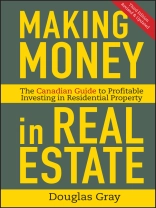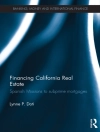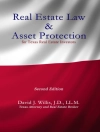Successful real estate investments play an essential role in Canadian investors’ portfolios. The growth in wealth in real estate markets has presented investors with tremendous opportunities to capitalize on and expand their range of investments, and has moved real estate investing from a niche product to a pillar of smart portfolio diversification. In
Making Money in Real Estate, 2nd Edition, Douglas Gray demystifies the Canadian real estate market for novice investors and presents new strategies for veteran investors. Learn to:
- Understand the real estate market cycles
- Find a property and assess its investment potential
- Build a trustworthy real estate team
- Arrange financing on good terms
- Use negotiating tactics that work
- Understand tax and legal issues
- Manage a property
- Avoid the pitfalls that many investors fall into
- Examine the pros and cons of non-residential property investment options
Readers of previous editions will appreciate the vital changes to mortgage rules, taxation and legislation, and the inclusion of information on commercial real estate. Thorough coverage in plain English makes Making Money in Real Estate, 2nd Edition the next logical step for investors who want to begin or expand their real estate portfolios, and is a critical and indispensable tool in investment decision making.
Spis treści
Preface xi
Acknowledgments xiii
Chapter 1: Understanding Real Estate Investment 1
Why Consider Investing in Real Estate? 2
Understanding the Real Estate Market 10
Establishing Your Investment Strategies 14
Key Investment Strategies to Consider 15
Buying with Partners 17
Summary 29
Chapter 2: Types of Residential Real Estate 31
Condominium 31
Single-Family House 45
Property for Renovation 54
Recreational Property 57
Multi-unit Dwelling 63
Apartment Building 63
Raw Land 66
Summary 68
Chapter 3: Finding and Evaluating the Right Property 69
What to Consider When Selecting a Property 69
Where to Find a Property for Sale 83
Determining the Value of the Property 88
Summary 102
Chapter 4: Selecting Your Advisory Team 103
Common Selection Criteria 103
Selecting a Realtor 106
Selecting a Lawyer 110
Selecting an Accountant 114
Selecting a Lender 117
Selecting a Financial Planner 117
Selecting a Mortgage Broker 122
Selecting a Building or Home Inspector 123
Selecting an Insurance Broker 126
Summary 128
Chapter 5: Understanding the Financing Aspects 129
What Is a Mortgage? 129
Types of Mortgages 130
Sources of Mortgages 138
Key Factors to Consider When Selecting a Mortgage 139
General Contents of a Mortgage 144
Determining the Amount of Mortgage Available 148
Applying for a Mortgage 149
Cost of Obtaining a Mortgage 153
Defaulting on Your Mortgage 159
Creative Financing 163
Dealing with Negative Cash Flow 164
Summary 166
Chapter 6: Understanding the Legal Aspects 167
Types of Ownership of Property 167
Understanding the Purchase-and-Sale Agreement 170
Services Provided by the Purchaser’s Lawyer 180
Services Provided by the Vendor’s Lawyer 185
The Listing Agreement 188
Forms of Legal Structure to Hold Investment
Property 190
Other Legal Cautions and Protections to Consider 193
Summary 200
Chapter 7: Understanding the Tax Aspects 201
Local and Regional Taxes 201
Provincial Taxes 202
Federal Taxes 202
Income Tax 210
Tax Implications of the Purchase Structure When Buying an Apartment Building 226
Summary 233
Chapter 8: Understanding the Insurance Aspects 235
Organizing Your Insurance Program 235
Types of Property Coverage 237
Types of General Insurance 244
Summary 248
Chapter 9: Buying Your Property 249
Selecting the Right Real Estate Agent 249
Determining a Property’s Value 252
Preparing the Offer 255
Presenting the Offer 256
Giving a Deposit 261
Making a Deal 262
Using a Lawyer 263
Insuring Gain 263
Closing the Deal 264
Summary 266
Chapter 10: Managing Your Property 267
Types of Management 267
Keeping Records 272
Finding the Right Tenant 275
Maintaining Rental Properties 285
Avoiding Common Fire Hazards 291
Improving the Bottom Line 293
Saving on Expenses 297
Summary 298
Chapter 11: Selling Your Property 299
Determining When to Sell 299
Determining How to Sell 301
Preparing to Sell 306
Preparing the Property 309
Closing the Sale 312
Moving On 314
Summary 315
Chapter 12: Understanding Financial and Estate Planning 317
An Introduction to Financial Planning 317
An Introduction to Estate Planning 317
Summary 331
Appendix 333
Form 1: Personal Cost-of-Living Budget 333
Form 2: Personal Net-Worth Statement 336
Form 3: Calculating Your Gross Debt-Service (GDS) Ratio 341
Form 4: Calculating Your Total Debt-Service (TDS) Ratio 342
Form 5: Projected Cash Flow 344
Form 6: Projected Income and Expense Statement 346
Form 7: Projected Balance Sheet 347
Form 8: Income Approach Worksheet 348
Form 9: Investment Property Analysis Checklist 350
Chart 1: Criteria for Determining Real Estate Cycle 352
Chart 2: Recovery on Renovation Costs 352
Chart 3: Amortization Period in Year 353
Chart 4: Interest Payments 353
Chart 5: Prepayment or Increased Payment Savings 354
Chart 6: Mortgage Amortization Chart 354
Chart 7: Monthly Mortgage Payments for Principal Plus Interest 355
Checklist 1: Real Estate Assessment Checklist 356
Checklist 2: Mortgage Checklist 364
Checklist 3: Real Estate Purchase Expenses Checklist 368
Checklist 4: Business Deductions Checklist 370
Checklist 5: Landlord and Tenant Suite-Inspection Checklist 372
Checklist 6: Master Checklist for Successful Real Estate Investing 376
Glossary 383
Further Education and Information 395
Index 397
O autorze
DOUGLAS GRAY, B.A., LL.B., formerly a practicing lawyer, has extensive experience in all aspects of real estate and mortgage financing. He has acted on behalf of buyers, sellers, developers, investors, lenders and borrowers. In addition, he has over 35 years of personal experience investing in real estate. He is the author of 26 best-selling real estate, business and personal finance books, and is as well a consultant and columnist.
Mr. Gray is president of the Canadia Enterprise Development Group Inc. and lives in Vancouver, BC. His website is www.homebuyer.ca.












